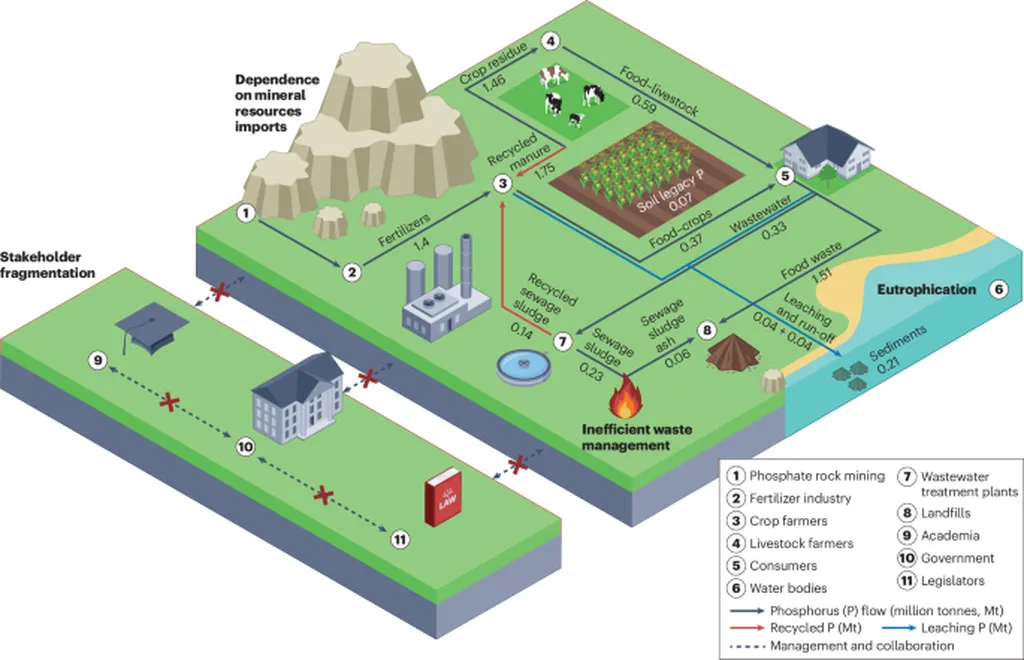In a world grappling with resource scarcity and climate change, a novel approach to phosphorus recovery could reshape the energy and agricultural sectors, according to groundbreaking research published in the journal *Sustainable Futures* (translated from the original title “Budućnost koja je održiva”). The study, led by Teodor Kalpakchiev from the Sustainability Research Institute at the University of Leeds, explores how the European Union’s Carbon Border Adjustment Mechanism (CBAM) could be leveraged to drive phosphorus recovery from wastewater, addressing both food security and industrial demands.
Phosphorus, a critical element for food production, is facing increasing competition from technological sectors where demand is projected to soar tenfold. “The EU’s demand for phosphorus in agriculture alone is expected to rise by up to 148%,” Kalpakchiev explains. “This creates a pressing need for innovative solutions to ensure sustainable supply chains and mitigate potential shortages.”
The research employs a Delphi-based qualitative scenario-building approach, engaging fourteen experts in phosphorus and carbon governance. By aligning with the shared socio-economic pathways (SSPs), the study outlines new framings and design features for CBAM that could advance phosphorus recovery and associated resource management.
In non-cooperative scenarios, the focus shifts towards biomethane production through anaerobic digestion, a technology that aligns with the fossil-fuel reframing of CBAM. “Biomethane offers a dual benefit,” Kalpakchiev notes. “It not only recovers valuable phosphorus but also contributes to renewable energy goals, making it a win-win for the energy sector.”
Conversely, cooperative scenarios in the long term highlight biochar as a carbon removal technology. Biochar, a stable form of carbon derived from biomass, can enhance soil fertility while sequestering carbon, thus addressing both agricultural and climate mitigation objectives.
The study also introduces the concept of a competitiveness framing, where primary phosphates are prioritized for food security, and recovered phosphorus is directed towards value-added industries. “This approach ensures that recovered phosphorus fetches a premium, incentivizing its extraction and use,” Kalpakchiev explains. “It’s a market-driven solution that aligns with commercial interests while promoting sustainability.”
Extending these measures through a development cooperation reframing and incorporating design features such as technological transfers and rebates for recycled content can fill innovation gaps and improve CBAM’s compliance with international law. The research also assesses the viability of backcasted policy measures, including real-time environmental feedback and the incorporation of recovery in the United Nations Framework for Classification of Resources (UNFC).
The implications for the energy sector are significant. By integrating phosphorus recovery into CBAM, the EU could set a precedent for global resource management, fostering innovation and driving investment in sustainable technologies. “This research offers a roadmap for policymakers and industry leaders to navigate the complexities of resource scarcity and climate change,” Kalpakchiev concludes. “It’s a call to action for a more sustainable and equitable future.”
As the world grapples with the challenges of resource depletion and climate change, this study provides a compelling vision for how policy mechanisms like CBAM can be repurposed to address critical resource needs. By bridging the gap between environmental sustainability and commercial viability, the research paves the way for a more resilient and resource-efficient future.

